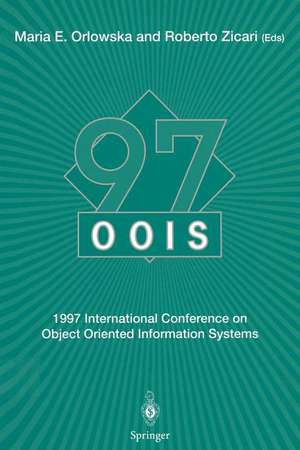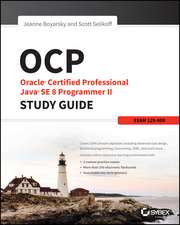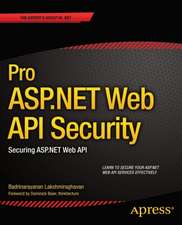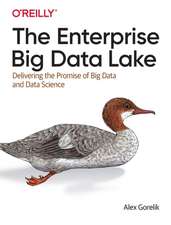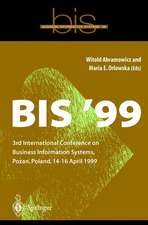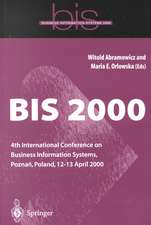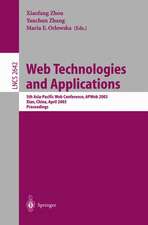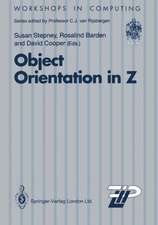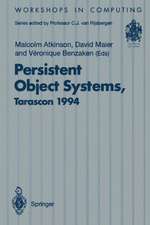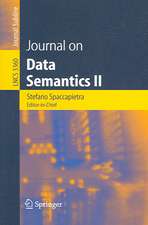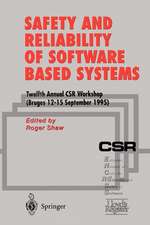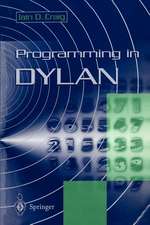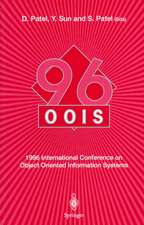OOIS’97: 1997 International Conference on Object Oriented Information Systems 10–12 November 1997, Brisbane Proceedings
Editat de Maria E. Orlowska, Roberto Zicarien Limba Engleză Paperback – 31 oct 1997
Preț: 657.49 lei
Preț vechi: 821.87 lei
-20% Nou
Puncte Express: 986
Preț estimativ în valută:
125.83€ • 136.63$ • 105.69£
125.83€ • 136.63$ • 105.69£
Carte tipărită la comandă
Livrare economică 22 aprilie-06 mai
Preluare comenzi: 021 569.72.76
Specificații
ISBN-13: 9783540761709
ISBN-10: 3540761705
Pagini: 540
Ilustrații: XXIII, 515 p. 39 illus.
Dimensiuni: 155 x 235 x 28 mm
Greutate: 0.75 kg
Ediția:Softcover reprint of the original 1st ed. 1998
Editura: SPRINGER LONDON
Colecția Springer
Locul publicării:London, United Kingdom
ISBN-10: 3540761705
Pagini: 540
Ilustrații: XXIII, 515 p. 39 illus.
Dimensiuni: 155 x 235 x 28 mm
Greutate: 0.75 kg
Ediția:Softcover reprint of the original 1st ed. 1998
Editura: SPRINGER LONDON
Colecția Springer
Locul publicării:London, United Kingdom
Public țintă
Professional/practitionerDescriere
This publication contains the proceedings of the 4th International Conference on Object-Oriented Information Systems. The first three OOIS conferences were held in London UK (1994), Dublin Ireland (1995) and again in London in 1996. In response to the Call for Papers we received 91 submissions which were reviewed by members of the Program Committee. Each paper was refereed by at least three reviewers, and following discussion with PC members, 40 of the papers were accepted for presentation at the conference, and for publication in this volume. In addition to the contributions from authors, this volume includes an abstract of the Keynote Speaker's presentation. At OOIS'97 in Brisbane in November, Dr Dan Fishman, the Chief Architect for Informix Software Inc. , traced some of the early developments in information systems through current day technology, and further explored possible future directions and potential for object -oriented information systems. The papers included in the proceedings consist of various aspects of object-oriented concepts and they have been presented to the reader under the following thematic sections: Object Oriented Methodologies Query Processing Modelling Issues I Transaction Processing and Concurrency Control Applications Modelling Issues II Re-Usability I Modelling Issues III Re-usability II Architectural Issues Object Orientation in Spatial Structures Database Design and Views Software Engineering/Development Large Scale Environments This conference has received tremendous support from the School of Information Technology at The University of Queensland.
Cuprins
Keynote Address: Object-Oriented Information Systems in the 21st Century.Dan Fishman (Chief Architect, Informix Software Inc, USA).- Object Oriented Methodologies: Complexity and Maintenance: A Comparative Study of Object-Oriented and Structured Methodologies. Richard J. (Dick) Whiddett, Michael A. Bailey (Massey University, New Zealand).Systems Oriented Analysis and Design Directions: A Suggested Evolution from the Object Model. Craig E. Perritt (BHP Information Technology, Australia).- Query Processing: Query Evaluation in an Object-Oriented Multimedia Mediator.Joachim Biskup, Jörgen Freitag, Yöcel Karabulut, Barbara Sprick (Universität Dortmund, Germany). A Concatenated Signature Scheme on Path Dictionary for Query Processing of Composite Objects.Hakgene Shin (Kijeon Womens Junior College, Korea), Heeju Lee, Jaewoo Chang (Chonbuk National University, Korea). An Approach to Query Translation in a Federation of Distributed Heterogeneous Database Systems.Xuequn Wu (Deutsche Telekom AG, Germany).- Modelling Issues I: A Practical Formally-Based Modelling Method for Object Oriented Information Systems.Kinh Nguyen (Victoria University of Technology, Australia), Tharam Dillon (La Trobe University, Australia).Viewpoints in Object-Oriented Databases.Hala Naja (CRIN, Centre de Recherche en Informatique de Nancy, France), Noureddine Mouaddib (IRIN, Institut de Recherche en Informatique de Nantes, France).Construction of a Modelling Framework for Health Information.Paul Ryder, Graham Pervan, Donald McDermid (Curtin University of Technology, Australia).- Transaction Processing and Concurrency Control: A Performance Evaluation for a Concurrency Control Mechanism in an ODBMS. Mohsen Beheshti (University of Houston-Downtown, USA). A Transaction Model to Support Disconnected Operation in a Mobile Computing Environment. A. Rasheed, A. Zaslavsky (Monash University, Australia). Legacy Transactional Systems Integration Framework. Simone Sidillot, Jian Liang (INRIA, France).-Applications: A Dynamic Business Object Architecture for an Insurance Industrial Project. Kitty Hung (South Bank University, UK), Yuan Sun (Compuware Ltd, UK), Tony Rose (CAD Consultants Ltd, UK). Automatic Drawing of Structured Digraphs. Hui Yao (NTT International Corporation, Japan). Making O2 become a WWW Server. Frank Buddrus, Sven-Eric Lautemann (Johann Wolfgang Goethe-Universitdt, Germany), Marco Bellavia (Universit`Statale di Milano, Italy)- Modelling Issues II: Subject Composition by Roles. Bent Bruun Kristensen (Odense University, Denmark). Assessing Inheritance for the Multiple Descendant Redefinition Problem in OO Systems. Philippe Li-Thiao-Ti, Jessie Kennedy, John Owens (Napier University, Scotland). An Aggregation Model and its C++ Implementation Manuel Kolp, Alain Pirotte (Universiti Catholique de Louvain, Belgium).- Re-Usability I: Behavioural Pattern Analysis Approach. R Chafi, C.R. Carlson (Illinois Institute of Technology, USA). Enhancing Reusability and Maintainability in NDOOM. Li Xuandong, Zheng Guoliang (Nanjing University, China). Temporal Business Objects: A Waste of Time? Paul Schleifer (South Bank University, UK), Yuan Sun (Compuware Ltd, UK), Dilip Patel (South Bank University, UK).- Modelling Issues III: Classifying Approaches to Object Oriented Analysis of Work with Activity Theory. Ole SmXrdal (University of Oslo, Norway). Race Scheduling Controls for Object Systems. En-Hsin Huang, Tzilla Elrad (Illinois Institute of Technology, USA). Quality of Service Object-Oriented Modeling at the Operating System Level. Hanan Bentaleb (Universiti Paul Sabatier, France).- Re-usability II: A Descriptive Language for Information Object Reuse through Virtual Documents. Anne-Marie Vercoustre, Frangois Paradis (CSIRO Mathematical & Information Sciences, Australia). Generic Reusable Business Object Modelling - A Framework and its Application in British Telecommunications plc. Islam Choudbury (South Bank University, UK), Yuan Sun (Compuware Ltd, UK), Dili
